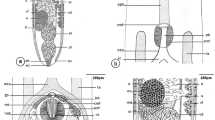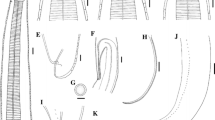Abstract
Habronema microstoma (Spirurida: Habronematidae) is found in the stomach of equines and uses the stable fly as its intermediate host. This nematode causes pathogenic effects in the stomach wall, skin and eye of the host. The present study reports the morphological features of adult worms, using scanning electron microscopy (SEM). The worms had two bilobed lateral lips surrounding the mouth. The buccal vestibule was markedly thickened, and two tridentate teeth were observed. Around the mouth, four sub-median cephalic papillae and two amphids were seen. A pair of lateral cervical papillae was present. There was only one lateral ala in both sexes. In the female, the vulva was opened in the middle of the body. In the male, there were wide caudal alae, and the spicules were unequal. At the posterior end of the male, four pairs of stalked pre-cloacal papillae, a single lateral pre-cloacal papilla, two pairs of post-cloacal papillae and a cluster of small papillae were present.















Similar content being viewed by others
References
Anderson RC (2000) Nematode parasites of vertebrates, their development and transmission. CABI, Wallingford, UK
Borgsteede FH, van Beek G (1998) Parasites of stomach and small intestine of 70 horses slaughtered in The Netherlands. Vet Q 20(1):31–34
Bowman DD, Lynn RC (1999) Georgis’ parasitology for veterinarians, 7th edn. Saunders, Philadelphia, PA, USA
Bucknell DG, Gasser RB, Beveridge I (1995) The prevalence and epidemiology of gastrointestinal parasites of horses in Victoria, Australia. Int J Parasitol 25(6):711–724
Cirak VY, Hermosilla C, Bauer C (1996) Study on the gastrointestinal parasite fauna of ponies in northern Germany. Appl Parasitol 37(4):239–244
Gasthuys FM, van Heerden M, Vercruysse J (2004) Conjunctival habronemiosis in a horse in Belgium. Vet Rec 154(24):757–758
Gawor JJ (1995) The prevalence and abundance of internal parasites in working horses autopsied in Poland. Vet Parasitol 58(1–2):99–108
Gibbons LM (1986) SEM guide to the morphology of nematode parasites of vertebrates. CABI, Wallingford, UK
Krecek RC, Malan FS, Reinecke RK, de Vos V (1987) Nematode parasites from Burchell’s zebras in South Africa. J Wildl Dis 23(3):404–411
Lapage G (1968) Veterinary parasitology, 2nd edn. Oliver and Boyd, Edinburg
Levine ND (1968) Nematode parasites of domestic animals and man. Burgess, USA
Lichtenfels JR (1975) Helminths of domestic equids: Illustrated keys to genera and species with emphasis on North American forms. Proc Helminthol Soc Wash 42:1–92
McLaren DJ (1974) The anterior glands of Necator americanus (Nematoda: Strongyloides). Ultrastructural studies. Int J Parasitol 4:25–34
McLaren DJ (1976) Nematode sense organs. Adv Parasitol 14:105–265
Mirzayans M, Anwar M, Maghsoudlou H (1974) Gastrointestinal helminths of horse in Iran. Trop Anim Health Prod 6:106
Mohamed FH, Abu Samra MT, Ibrahim KE, Idris SO (1990) Cutaneous habronemiasis in horses and domestic donkeys (Equus asinus asinus). Rev Elev Med Vet Pays Trop 42(4):535–540
Naem S (2007) First description of the horse stomach worm, Habronema muscae (Spirurida: Habronematidae) by scanning electron microscopy. Parasitol Res (in press)
Nandi AP (2005) Data on the morphology of Viguiera dicrurusi Gupta, 1960 (Nematoda: Habronematidae) with notes on related forms. Folia Parasitol 52:261–266
Nandi AP, Majumdar G (1987) On a new species of the genus Torquatoides (Williams 1929) (Nematoda: Habronematidae) with a redescription of Torquatoides balanocephala (Gendre 1922) from birds of West Bengal, India. Riv Parassitol 4:369–373
Pandey VS, Eysker M (1988) Parasites of the stomach in donkeys of the highveld of Zimbabwe. Vet Q 10(4):246–248
Pandey VS, Ouhelli H, Verhulst A (1992) Epidemiological observations on stomach worms of donkeys in Morocco. Vet Res Commun 16(4):273–279
Ricci M, Sabatini A (1992) Parasitic helminths of the cecum and colon of equidae in Italy. Parasitologia 34(1–3):53–60
Scialdo-Krecek RC, Reinecke RK, Biggs HC (1983) Studies on the parasites of zebras. III Nematodes of the mountain zebra from the farm “Kelpie” and the Namib-Naukluft Park, South West Africa/Namibia. Onderstepoort J Vet Res 50(4):283–290
Soulsby EJL (1965) Textbook of veterinary clinical parasitology, vol. 1 Helminths. Blackwell, Oxford, UK
Soulsby EJL (1986) Helminths, arthropods and protozoa of domesticated animals. Bailliere Tindall, London, UK
Traversa D, Giangaspero A, Galli P, Paoletti B, Otranto D, Gasser RB (2004a) Specific identification of Habronema microstoma and Habronema muscae (Spirurida, Habronematidae) by PCR using markers in ribosomal DNA. Mol Cell Probes 18(4):215–221
Traversa D, Giangaspero A, Iorio R, Otranto D, Paoletti B, Gasser RB (2004b) Semi-nested PCR for the specific detection of Habronema microstoma or Habronema muscae DNA in horse faeces. Parasitol 129(Pt 6):733–739
Traversa D, Iorio R, Capelli G, Paoletti B, Bartolini R, Otranto D, Giangaspero A (2006) Molecular cross-sectional survey of gastric habronemosis in horses. Vet Parasitol 141(3–4):285–290
Trees AJ, May SA, Baker JB (1984) Apparent case of equine cutaneous habronemiasis. Vet Rec 115(1):14–15
Zhang L, Brooks DR (2004) Torquatoides trogoni N. Sp. and Excisa ramphastina N. Sp. (Nematoda: Habronematoidea: Habronematidae) in birds from the area de Conservacion Guanacaste, Costa Rica. J Parasitol 90(3):626–630
Zhang L, Brooks DR (2005) Parhadjelia cairinae N. Sp. (Nematoda: Habronematoidea: Habronematidae) in the Muscovy duck, Cairina moschata (Linnaeus, 1758) (Aves: Anseriformes: Anatidae), from the area de Conservacion Guanacaste, Costa Rica. J Parasitol 91(2):438–440
Zhang L, Brooks DR, Causey D (2004) Procyrnea Chabaud, 1958 (Nematoda: Habronematoidea: Habronematidae) in birds from the area de Conservacion Guanacaste, Costa Rica, including descriptions of 3 new species. J Parasitol 90(2):364–372
Acknowledgment
The author expresses her gratitude to Professor Larry A. Arsenault, head of the electron microscope facility, Department of Pathology and Molecular Medicine, McMaster University, Canada, for his assistance in providing all facilities during the study. In addition, the valuable help of Mr. Ernie Spitzer, Chief technician, and all technicians in the electron microscope facility is acknowledged. The author thanks Dr. Donato Traversa of the Department of Biomedical Comparative Sciences, Faculty of Veterinary Medicine, University of Teramo, Italy, for providing some valuable references. Finally, the author is particularly indebted to Dr. Christine M. Budke of Texas A&M University, USA, for her continuous support and critical review of the manuscript.
Author information
Authors and Affiliations
Corresponding author
Rights and permissions
About this article
Cite this article
Naem, S. First SEM observations on adult Habronema microstoma (Spirurida: Habronematidae), a parasite of the horse. Parasitol Res 101, 743–749 (2007). https://doi.org/10.1007/s00436-007-0544-5
Received:
Accepted:
Published:
Issue Date:
DOI: https://doi.org/10.1007/s00436-007-0544-5




